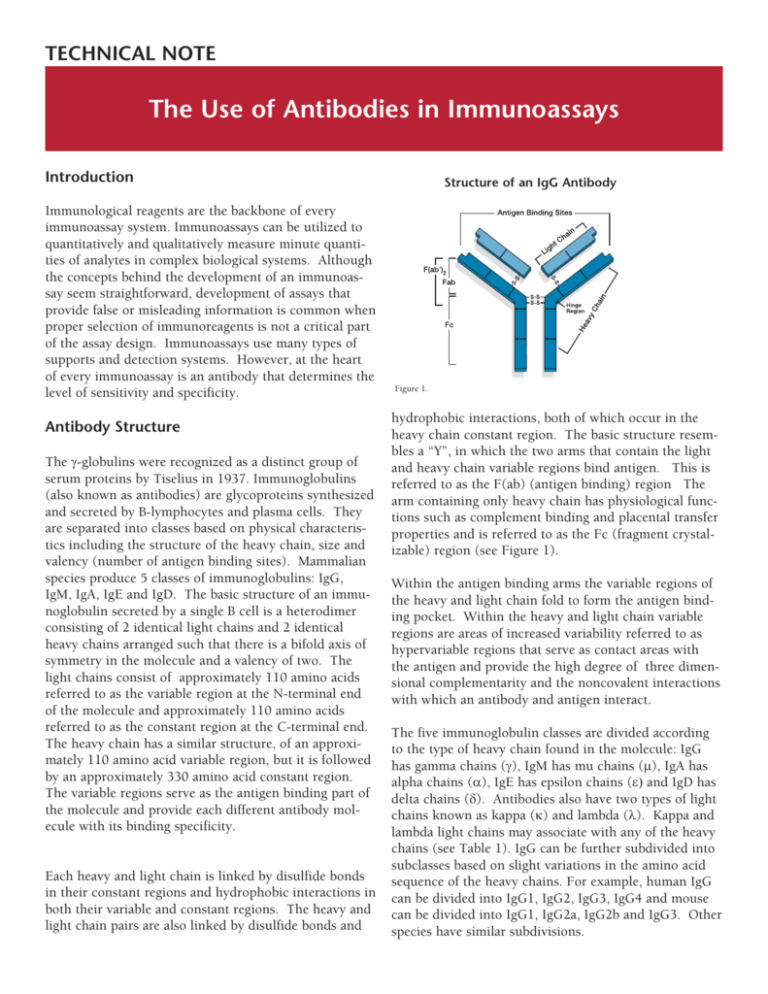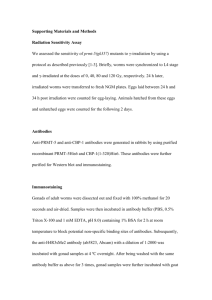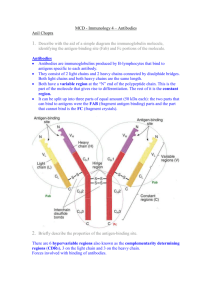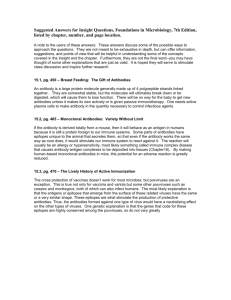
TECHNICAL NOTE
The Use of Antibodies in Immunoassays
Introduction
Immunological reagents are the backbone of every
immunoassay system. Immunoassays can be utilized to
quantitatively and qualitatively measure minute quantities of analytes in complex biological systems. Although
the concepts behind the development of an immunoassay seem straightforward, development of assays that
provide false or misleading information is common when
proper selection of immunoreagents is not a critical part
of the assay design. Immunoassays use many types of
supports and detection systems. However, at the heart
of every immunoassay is an antibody that determines the
level of sensitivity and specificity.
Antibody Structure
The -globulins were recognized as a distinct group of
serum proteins by Tiselius in 1937. Immunoglobulins
(also known as antibodies) are glycoproteins synthesized
and secreted by B-lymphocytes and plasma cells. They
are separated into classes based on physical characteristics including the structure of the heavy chain, size and
valency (number of antigen binding sites). Mammalian
species produce 5 classes of immunoglobulins: IgG,
IgM, IgA, IgE and IgD. The basic structure of an immunoglobulin secreted by a single B cell is a heterodimer
consisting of 2 identical light chains and 2 identical
heavy chains arranged such that there is a bifold axis of
symmetry in the molecule and a valency of two. The
light chains consist of approximately 110 amino acids
referred to as the variable region at the N-terminal end
of the molecule and approximately 110 amino acids
referred to as the constant region at the C-terminal end.
The heavy chain has a similar structure, of an approximately 110 amino acid variable region, but it is followed
by an approximately 330 amino acid constant region.
The variable regions serve as the antigen binding part of
the molecule and provide each different antibody molecule with its binding specificity.
Each heavy and light chain is linked by disulfide bonds
in their constant regions and hydrophobic interactions in
both their variable and constant regions. The heavy and
light chain pairs are also linked by disulfide bonds and
Structure of an IgG Antibody
Figure 1.
hydrophobic interactions, both of which occur in the
heavy chain constant region. The basic structure resembles a “Y”, in which the two arms that contain the light
and heavy chain variable regions bind antigen. This is
referred to as the F(ab) (antigen binding) region The
arm containing only heavy chain has physiological functions such as complement binding and placental transfer
properties and is referred to as the Fc (fragment crystalizable) region (see Figure 1).
Within the antigen binding arms the variable regions of
the heavy and light chain fold to form the antigen binding pocket. Within the heavy and light chain variable
regions are areas of increased variability referred to as
hypervariable regions that serve as contact areas with
the antigen and provide the high degree of three dimensional complementarity and the noncovalent interactions
with which an antibody and antigen interact.
The five immunoglobulin classes are divided according
to the type of heavy chain found in the molecule: IgG
has gamma chains (), IgM has mu chains (), IgA has
alpha chains (), IgE has epsilon chains ( and IgD has
delta chains (). Antibodies also have two types of light
chains known as kappa () and lambda (). Kappa and
lambda light chains may associate with any of the heavy
chains (see Table 1). IgG can be further subdivided into
subclasses based on slight variations in the amino acid
sequence of the heavy chains. For example, human IgG
can be divided into IgG1, IgG2, IgG3, IgG4 and mouse
can be divided into IgG1, IgG2a, IgG2b and IgG3. Other
species have similar subdivisions.
Antibody Class Characteristics
Class
Heavy
Chain
Light
Chain
Approximate
Molecular
Weight
Molecular
Formula
IgG
or
150,000
22 or 22
IgM
or
950,000
(22 )5 or (22)5
IgA
or
150,000500,000
(22 )n or (22)n
where n=2,4 or 6
IgE
or
190,000
22 or 22
IgD
or
180,000
22 or 22
Adapted from Harlow E. and Lane D., Antibodies, A Laboratory Manual,
Cold Spring Harbor (1988)
Table 1.
Antibodies can be enzymatically digested into F(ab’)2,
Fc, and F(ab) components. The Fc fraction does not
contain a specific antigen-binding domain but contains
regions to which cell surface receptors, serum and bacterial proteins may bind. When IgG is digested with
pepsin, enzymatic cleavage occurs on the C-terminal side
of the disulfide bonds that hold the two heavy chains
together. This results in two F(ab) regions that are held
together by disulfide bonds and is referred to as F(ab’)2.
F(ab’)2 has the same valency as normal IgG and a molecular weight of approximately 110,00 daltons. Papain
digestion cleaves on the N-terminal side of the disulfide
bonds that hold the two heavy chains together yielding
two molecules of F(ab) and one Fc. The F(ab) fragment is half the molecular weight of the F(ab’)2 and has
a valency of only one.
Antibody Class Functions
IgG Antibodies: IgG is the dominant antibody found in
blood. Functionally, IgG promotes the uptake of microorganisms by immune cells and is responsible for longterm protection from disease as a secondary response.
For example, this antibody is used in the detection of
blood viruses.
IgM Antibodies: IgM is the first antibody produced as
a primary response to infection and is very effective in
activating complement and destroying bacteria. It is a
pentamer of the basic (two light chain two heavy chain)
structure. The pentamer is held together by extra disulfide bonds formed near the C-terminal end of the heavy
chains plus a short polypeptide referred to as J chain.
IgM is often used in assays for early detection of infection.
IgA Antibodies: IgA is known as the secretory antibody.
It is found in mucous membrane secretions as a dimer
associated with a secretory chain. It protects the respiratory and gastrointestinal tracts from infection. In some
mammals IgA is a major factor in milk that passively
protects the newborn.
IgE Antibodies: IgE binds to the Fc receptors on mast
cells and basophils and triggers the allergic response.
It is also associated with defense against parasites. It
is present in blood in extremely small concentrations.
Typically, this antibody is used in allergy testing.
IgD Antibodies: IgD is a minor blood component. It is
typically bound to the surface of B-lymphocytes.
Antibody-Antigen Interactions - Some useful definitions
Immunogen - What is injected into an animal to
induce an immune response.
Figure 2.
Digestion of an antibody with pepsin releases the two antigen binding domains
bound together by disulfide bonds, resulting in the F(ab’)2 fragment. Digestion
of an antibody with the enzyme papain splits the immunoglobulin molecule into
three fragments of similar size: two F(ab’) fragments and one Fc fragment.
Antigen - The molecule that an antibody binds with
high affinity and specificity. Often these molecules
are large, sometimes they are proteins that are even
larger than an antibody molecule. In fact, in some
cases they are not a single molecule, but may be an
organism such as a bacteria or virus.
Epitope- What an antigen binding site actually envelops and binds to. A large protein or an organism
may have many epitopes. In some cases each one is
different in shape. In some cases the same epitope is
repeated several times.
Antibodies are defined functionally by the epitope they
specifically recognize. Binding to an epitope occurs
through weak noncovalent interactions such as: hydrophobic bonding; van der Waals forces; hydrogen bonding
and ionic interactions (in order of increasing strength).
Each of these interactions alone are respectively 1000100 times weaker than a covalent bond. It is the sum of
many of these interactions between an epitope and an
antibody binding site that give this complex a very low
Kd (dissociation constant). In addition, these types of
interactions only occur over very short distances so it is
the complementarity of shape between an epitope and
an antibody binding site (“lock and key” or “hand and
glove”) that allows the two to come close enough together for these forces to exert their strength.
The shape of an antigen binding pocket can vary tremendously depending on the shape of the antigen being
bound. Small molecules or short peptides typically bind
in a pocket or groove lying between the heavy and light
chain variable regions and there may only be contact
(noncovalent interactions) between 1-2 amino acids in
the antibody molecule and the epitope. Other antigens
such as large proteins or organisms can be larger than
the antibody molecule itself. In these cases the complementary area of interaction may be an extended surface
with an area of 500-1000 A2 . Within this area, 15 - 20
amino acids in the antibody may contact the same number in the epitope.
an antibody molecule has two or more binding sites.
Avidity, another measure of antigen-antibody interaction,
takes this into account. Affinity is one determinant of
avidity; others include the valency of the antibody (number of antigen binding sites), valency of the antigen, and
conformational changes in the antibody or antigen upon
binding. Thus an antigen with multiple repeating epitopes will more strongly interact with an antibody than
the same antigen if it did not have repeating
epitopes. In addition this antigen would more strongly
interact with an IgM antibody (higher valency) than an
IgG antibody with the same binding sites. Avidity is
not a thermodynamic property, rather, it can only be
described functionally under given assay conditions. It
is for this reason that many researchers utilize antibody
titer to characterize antibody activity and concentration
in a biological sample.
Secondary Antibodies
While antibodies have antigen binding specificity, they
can also serve as antigens themselves. For instance, the
constant regions of both heavy and light chains in an IgG
from a mouse or a human are different in amino acid
sequence and thus the three dimensional structure from
the heavy and light chains of IgG from a goat. These differences do not create dramatic changes in the structure
of the antibody but they do create epitopes that the goat
does not have on its own IgG. Therefore, if we inject
mouse IgG into a goat it will produce IgG that will react
with mouse IgG. This would be referred to as goat anti
mouse IgG. Since a mouse antibody is a large molecule
it will have many epitopes, some on the heavy chain and
some on the light chain, mostly in the constant regions.
Heavy and Light Chain Cross-Reactivity
Antibody affinity is determined by the rate of formation
of an antibody-epitope complex relative to the rate of its
dissociation.
The rate of formation (ka) of [Antigen Antibody]
complexes depends on the rate of diffusion of the two
molecules in the solution while the rate of breaking the
complexes (kd) depends on the strength of the interaction (complementarity + noncovalent bonds).
Thus, affinity is a thermodynamic property indicative of
the likelihood that the epitope and the antibody will be
in a complex. Affinity is measured between one epitope
and one antibody binding site, but as described above
Antibodies consist of both heavy and light chains. Thus
the goat anti-IgG referred to above will actually be anti
IgG (H+L), and recognize sites on both the heavy and
light chains. These antibodies are widely used to detect
IgG and may also recognize IgA and IgM due to common light chain epitopes between the classes. The
heavy chains of antibody classes each possess distinct
regions that are specific for that class. They also have
regions that are similar to each other, which can cause
cross-reactivity in immunoassays. Polyclonal antibodies
produced against the heavy chain of IgG contain many
populations of antibodies that recognize different regions
on the IgG heavy chain. Some of these regions are also
similar to the IgA and IgM heavy chains. Therefore, this
antibody consists of subpopulations that also recognize
IgM and IgA. To make the antibody specific for the IgG
heavy chain, these subpopulations must be removed or
reduced. To do this, the purified antibody is further
adsorbed by passing it over affinity columns with immobilized whole IgM and IgA antibodies containing both
heavy and light chains. The antibody populations which
recognize IgM and IgA are adsorbed onto the columns,
reducing reactivity to IgM and IgA heavy chains, as well
as common light chain activity. Antibodies specific
for the IgG heavy chain are collected and used for the
final product. Heavy chain specific antibodies, i.e. antiIgG(), are useful for the quantitation of the heavy chain
antibody only in samples containing other immunoglobulins and proteins such as serum or tissue culture media.
Species Cross-Reactivity
Immunoglobulins of related animal species often share
similarities in structure and sequence. For example,
affinity purified antibodies against mouse IgG may recognize similar epitopes on human IgG. To minimize crossreactivity between mouse and human species, antibodies
to mouse immunoglobulins are adsorbed against immobilized human serum on an affinity column. The resulting antibody (Anti-Mouse IgG, Human Serum Adsorbed
or HSA) is highly specific to mouse IgG and will have
only minimal reactivity with human IgG or any other
human serum components. Select antibody preparations
are further adsorbed against multiple animal species to
reduce reactivity to shared regions among these species.
KPL’s extra-serum adsorbed (XSA) antibodies are crossadsorbed to as many as 9 different species for the greatest possible specificity. These highly specific antibodies
are ideal for use in microwell ELISA, membrane blotting,
immunohistochemistry, flow cytometry, immunoprecipitation and hybridoma screening.
Antibodies are commercially available in a variety of
forms, such as antiserum, ascites containing monoclonal
antibody, purified immunoglobulin, and affinity purified
antibody. These may vary significantly in antibody concentration, purity and heterogeneity. The antibody may
be provided as a whole molecule or as an antibody fragment: F(ab’)2, Fc or F(ab). Which antibody is chosen
and in what form depends on the particular application.
The goal is to choose an antibody system that provides
the greatest sensitivity with the least amount of nonspecific activity.
Monoclonal Antibodies
Monoclonal antibodies are produced following the fusion
of myeloma cells with antibody secreting B-cells. The
resultant continuous cell line (hybridoma) produces
large quantities of homogeneous, well defined, single
epitope antibody. The availability of large quantities of
continuously produced antibody allows for greater standardization and quality control of the antibody reagent.
Therefore, monoclonal antibodies are more precisely
characterized, legally protected and have greater acceptance by regulatory agencies when used in diagnostic
applications.
Because monoclonal antibodies are the result of cell
fusion, these proteins may have peculiar differences
from other immunoglobulins. They may not precipitate
under standard conditions. They may also demonstrate
unpredictable binding patterns to Protein A and Protein
G. These antibodies may also not purify under ionic
exchange conditions as one might expect. These properties may make the purification of monoclonal antibody from ascites a difficult and expensive proposition.
Monoclonal antibodies are also very sensitive to conjugation, and often lose activity once conjugated to enzymes
such as horseradish peroxidase or alkaline phosphatase.
However, one can usually conjugate monoclonal antibodies with small molecular weight molecules such as
biotin with minimal risk of losing antigen-binding activity.
The advantages of using monoclonal antibodies in specific applications are numerous. Because monoclonal
antibodies can be selected based on affinity during
production, high affinity antibodies may be obtained.
Monoclones make excellent primary antibodies in heterogeneous ELISA and other immunoassays. In competitive assays for drug, hormone or other small analytes,
monoclonal antibodies are the best choice for quantitative and reproducible assays. Because of the defined
specificity of the antibody reactivity these reagents can
be used in epitope mapping and characterization of fine
antigenic structure.
Polyclonal Antibodies
Polyclonal antibodies are obtained from the serum of
animals immunized with a particular antigen. The antibody pool obtained from serum is the result of many
B-cell clones, each secreting one specific antibody.
Antiserum refers to a pool of serum containing all of
the antibody fraction plus other serum proteins. Due
to serum proteins other than immunoglobulins, immunoassays using unpurified antiserum components usually exhibit high background, poor dynamic range, and
low sensitivity. Antibody purified from antiserum is
obtained by selective precipitation and various forms of
chromatography. An IgG fraction may only contain 10%
specific antibody and is only slightly more purified than
antiserum. However, this fraction is void of many serum
proteins that can interfere with immunoassays.
An affinity purified antibody (see “How KPL Purifies Its
Antibodies”) is one that has been purified from the IgG
fraction by affinity chromatography to a selected antigen.
Affinity purified antibodies exhibit the highest specificity and sensitivity that can be obtained from a circulating serum antibody pool. These antibodies exhibit specific activity to a population of antigenic determinants
including continuous and discontinuous antigenic sites.
Affinity purified antibodies are useful as primary and
secondary antibodies in heterogeneous immunoassays
and make excellent secondary anti-species (e.g., Goat
anti-human IgG) antibody conjugates. Anti-bacterial
membrane or viral coat proteins are directed to multiple
antigenic determinants. Therefore, unlike monoclonal antibodies, affinity purified antibodies can be used
as both the capture and detection antibody in capture
immunoassay systems.
Although affinity purified polyclonal antibodies have
many advantages, they are not the antibody of choice
for some immunoassay systems. In competitive assays
designed for measuring drugs or small molecular weight
analytes, polyclones are not as reliable as monoclonal
antibodies. Since an affinity purified polyclonal antibody
contains multiple individual antibodies with varying
affinities for an epitope, the affinity constant can not be
accurately determined. Multiple antibody affinities may
increase the assay variation about a standard curve in
comparison to an assay designed with a single monoclonal antibody. Affinity purified antibodies require consistent antiserum quality. Due to the normal variation
in the animals producing the antibody, there is greater
variation in the final activity of an affinity purified polyclonal antibody than a monoclonal antibody. For systems that require exact reproducibility, monoclonal antibodies may be a better choice than polyclonal. For assays
requiring broad spectrum specificity to large molecular
weight antigens, affinity purified polyclonal antibodies
are the clear choice.
Antibody Fragments
F(ab’)2 may be very useful tools for certain situations.
They can be coupled as easily as whole Ig with enzymes
and fluorophores, but the lack of an Fc region may
decrease background from unwanted interactions with
Fc binding proteins found on tissue cells and bacteria.
In addition, the reduced size may permit more rapid
diffusion of the molecule into complex samples such as
tissues. Higher sensitivity may be obtained from F(ab’)2
than whole molecule antibodies due to the total decrease
in mass while maintaining the same antibody valency.
Because the F(ab) antibody has only a valence of one,
there is decreased stability of the antigen-antibody interaction due to decreased avidity (the cooperative effects
of having two identical binding sites in close proximity).
In applications where nonspecific activity due to other
serum proteins is of major concern, the F(ab’)2 is the
antibody of choice over a whole molecule.
Enzyme Conjugates
Many immunodetection methods use secondary antibodies conjugated to enzymes in order to amplify the signal
via the catalytic properties of the enzyme. The enzymes
most commonly used for this purpose are horseradish peroxidase (HRP), alkaline phosphatase (AP), and
to a lesser extent, -galactosidase. Each enzyme offers
unique features that, under the right conditions, makes
it the optimal choice. Historically, HRP substrates have
been shown to be more sensitive in immunoassays as
compared to AP substrates. This is primarily due to
the faster catalytic rate of HRP. Thus, more product is
generated in a shorter incubation time. However, these
products tend to fade after development, and they can
be hazardous. Additionally, H2O2, a cosubstrate in the
reaction, ultimately limits the activity of HRP by oxidizing heme iron. This can result in a shorter linear incubation period than seen for AP. In contrast, AP exhibits a
slower catalytic rate, but is not self-limiting. Reaction
rates remain linear over longer periods of time; therefore,
sensitivity can be improved by allowing the reaction to
proceed for longer incubations. AP substrates also tend
to be less toxic and thus easier to handle. -galactosidase
conjugates are limited in application by a relative lack of
substrate choices and because the size and structure of
the enzyme make it difficult to conjugate to antibodies
while maintaining activity and solubility. Another factor influencing the choice of conjugate is the presence
of endogenous enzyme activity in the sample which may
interfere with the assay and/or increase background signal2. Mammalian tissues often exhibit peroxidase activity, particularly in cells of hematopoietic lineage (blood
cells, macrophages, etc.). In these tissues, AP conjugates
present a distinct advantage. Alternatively, different isoenzymes of alkaline phophatase are expressed in many
tissues. AP conjugates are typically prepared using the
intestinal isoenzymes, which are not inhibited by levamisole. Thus, it is often possible to inhibit endogenous AP
activity by levamisole pretreatment. The obvious exception is in intestinal tissue, where HRP would be the conjugate of choice.
References:
1. Porstmann, B. et al. (1985). J Immunol. Methods 79:27-37.
2. Bratthauer, G. L. (1994). in Jovois, L.C., ed. Methods in
Molecular Biology, Vol. 34: Immunocytochemical Methods
and Protocols. Humana Press Inc., Totowa, NJ, 155-164.
Summary
A wide variety of antibody products are available to
the researcher designing an immunoassay. Each has
advantages and disadvantages in specific applications.
The goal of the researcher is to find the best antibody
product for each application, minimizing non-specific
reactions while increasing sensitivity and dynamic range.
To accomplish this goal, one must be cognitive of the
underlying physical chemistry involved in antibody-antigen interaction during each phase of the immunoassay to
obtain meaningful and reliable results.
www.seracare.com
800.676.1881
508.244.6400
www.kpl.com
800.638.3167
301.948.7755
© Copyright 2005 KPL, Inc. All rights reserved.
ML-302-04
ISO 9001 Registered








